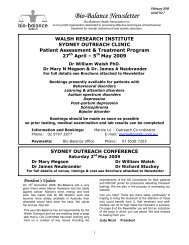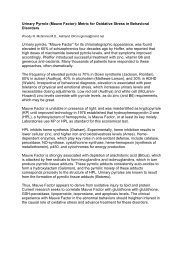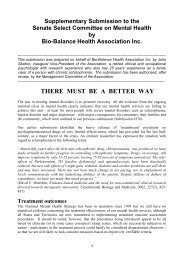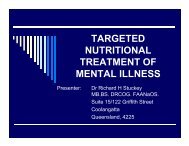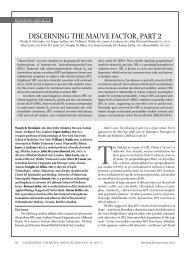The Teen Brain:Primed to Learn, Primed to Take RisksBy Jay N. Giedd, M.D.During adolescence the brain’s ability to change isespecially pronounced—and that can be a double-edgedsword. Jay N. Giedd, a child and adolescent psychiatristat the National Institute of Mental <strong>Health</strong> who specializesin brain imaging, points out that the brain’s plasticityallows adolescents to learn and adapt, which paves theway for independence. But it also poses dangers:different rates of development can lead to poor decisionmaking, risk taking—and, in some cases, diagnosabledisorders.Across cultures and millennia, the teen years have beennoted as a time of dramatic changes in body andbehaviour. During this time most people successfullynavigate the transition from depending upon family tobecoming a self-sufficient adult member of the society.However, adolescence is also a time of increasedconflicts with parents, mood volatility, risky behaviourand, for some, the emergence of psychopathology.The physical changes associated with puberty areconspicuous and well described. The brain’stransformation is every bit as dramatic but, to theunaided eye, is visible only in terms of new and differentbehaviour. The teen brain is not broken or defective.Rather, it is wonderfully optimised to promote oursuccess as a species.Beginning in childhood and continuing throughadolescence, dynamic processes drive braindevelopment, creating the flexibility that allows the brainto refine itself, specialize and sharpen its functions forthe specific demands of its environment. Maturingconnections pave the way for increased communicationamong brain regions, enabling greater integration andcomplexity of thought. When what we call adolescencearrives, a changing balance between brain systemsinvolved in emotion and regulating emotionspawns increased novelty seeking, risk taking and a shifttoward peer-based interactions.These behaviours, found in all social mammals,encourage separating from the comfort and safety of ourfamilies to explore new environments and seekunrelated mates. 1 However, these potentially adaptivebehaviours also pose substantial dangers, especiallywhen mixed with modern temptations and easy accessto potent substances of abuse, firearms and high-speedmotor vehicles.In many ways adolescence is the healthiest time of life.The immune system, resistance to cancer, tolerance forheat and cold and several other variables are at theirpeak. Despite physical strengths, however, illness andmortality increase 200 percent to 300 percent. As of2005, the most recent year for which statistics areavailable, motor vehicle accidents, the No. 1 cause,accounted for about half of deaths. Nos. 2 and 3 werehomicide and suicide. 2 Understanding this healthy-body,risk-taking-brain paradox will require greater insight intohow the brain changes during this period of life. Suchenhanced understanding may help to guide interventionswhen illnesses emerge or to inform parenting oreducational approaches to encourage healthydevelopment.Different parts of the brain mature at varying rates duringadolescence. This image indicates an average decrease ingrey matter volumes between ages 5 and 20, thanks tothe pruning of neural connections. Areas that mediate“executive functioning” mature later than areasresponsible for basic functions. (Image courtesy of Jay N.Giedd, M.D.)Adolescent Neurobiology: Three ThemesThe brain, the most protected organ of the body, hasbeen particularly opaque to investigation of what occursduring adolescence. But now the picture emerging fromthe science of adolescent neurobiology highlights boththe brain’s capacity to handle increasing cognitivecomplexity and an enormous potential for plasticity—thebrain’s ongoing ability to change. The advent ofstructural and functional magnetic resonance imaging(MRI), which combines a powerful magnet, radio waves,and sophisticated computer technology to provideexquisitely accurate pictures of brain anatomy andphysiology, has opened an unprecedented window intothe biology of the brain, including how its tissuesfunction and how particular mental or physical activitieschange blood flow. Because the technique does not useionising radiation, it is well suited for pediatric studiesand has launched a new era of neuroscience. Threethemes emerge from neuroimaging research inadolescents:January 2013 6Serial No 15
1. Brain cells, their connections and receptors forchemical messengers called neurotransmitterspeak during childhood, then decline inadolescence.2. Connectivity among brain regions increases.3. The balance among frontal (executive-control)and limbic (emotional) systems changes.These themes appear again and again in our studies ofthe biological underpinnings for cognitive andbehavioural changes in teenagers.Theme 1: Childhood Peaks Followed by AdolescentDeclines in Cells, Connections and ReceptorsThe brain’s 100 billion neurons and quadrillion synapsescreate a multitude of potential connection patterns. Asteens interact with the unique challenges of theirenvironment, these connections form and re-form, givingrise to specific behaviours—with positive or negativeoutcomes. This plasticity is the essence of adolescentneurobiology and underlies both the enormous learningpotential and the vulnerability of the teen years.Neuroimaging reveals that grey matter volumes—whichreflect the size and number of branches of brain cells—increase during childhood, peak at different timesdepending on the location in the brain, decline throughadolescence, level off during adulthood and then declinesomewhat further in senescence. This pattern ofchildhood peaks followed by adolescent declines occursnot only in grey matter volumes but also in the numberof synapses and the densities of neurotransmitterreceptors. 3 This one-two punch—overproductionfollowed by competitive elimination—drives complexitynot only in brain development but also across myriadnatural systems.Theme 2: Increased ConnectivityMany cognitive advances during adolescence stem fromfaster communication in brain circuitry and increasedintegration of brain activity. To use a language metaphor,brain maturation is not so much a matter of adding newletters as it is one of combining existing letters intowords, words into sentences and sentences intoparagraphs.“Connectivity” characterizes several neuroscienceconcepts. In anatomic studies connectivity can mean aphysical link between areas of the brain that sharecommon developmental trajectories. In studies of brainfunction, connectivity describes the relationship betweendifferent parts of the brain that activate together duringa task. In genetic studies it refers to different regions thatare influenced by the same genetic or environmentalfactors. All of these types of connectivity increase duringadolescence.In structural magnetic resonance imaging studies of brainanatomy, connectivity, as indicated by the volume ofwhite matter—bundles of nerve cells’ axons, which linkvarious regions or areas of the brain—increasesthroughout childhood and adolescence and continues togrow until women reach their 40s and men their 30s. Thefoundation of this increase in wiring is myelination, theformation of a fatty sheath of electrical insulation aroundaxons, which speeds conduction of nerve impulses. Theincrease is not subtle—myelinated axons transmitimpulses up to 100 times faster than unmyelinatedaxons. Myelination also accelerates the brain’sinformation processing via a decrease in the recoverytime between firings. That allows up to a 30-fold increasein the frequency with which a given neuron can transmitinformation. This combination—the increase in speedand the decrease in recovery time—is roughly equivalentto a 3,000-fold increase in computer bandwidth.However, recent investigations into white matter arerevealing a much more nuanced role for myelin than asimple “pedal to the metal” increase in transmissionspeed. Neurons integrate information from otherneurons by summing excitatory and inhibitory input. Ifexcitatory input exceeds a certain threshold, thereceiving neuron fires and initiates a series of molecularchanges that strengthens the synapses, or connections,from the input neurons. Donald Hebb famouslydescribed this process in 1940 as “cells that fire togetherwire together.” It forms the basis for learning. In orderfor input from nearby and more distant neurons to arrivesimultaneously, the transmission must be exquisitelytimed. Myelin is intimately involved in the fine-tuning ofthis timing, which encodes the basis for thought,consciousness and meaning in the brain. The dynamicactivity of myelination during adolescence reflects howmuch new wiring is occurring.On the flip side, recent research reveals that myelinationalso helps close the windows of plasticity by inhibitingaxon sprouting and the creation of new synapses. 4 Thus,as myelination proceeds, circuitry that is used the mostbecomes faster, but at the cost of decreased plasticity.Advances in imaging techniques such as diffusion tensorimaging (DTI) and magnetization transfer (MT) imaginghave helped spark interest in these processes by allowingresearchers to characterize the direction of axons andthe microstructure of white matter. These newtechniques further confirm an increase in white matterorganization during adolescence, which correlates inspecific brain regions with improvements in language, 5reading, 6 ability to inhibit a response 7 and memory. 5Functional magnetic resonance imaging studies alsoconsistently demonstrate increasing and more efficientcommunication among brain regions during child andadolescent development. We can measure thisJanuary 2013 7Serial No 15



